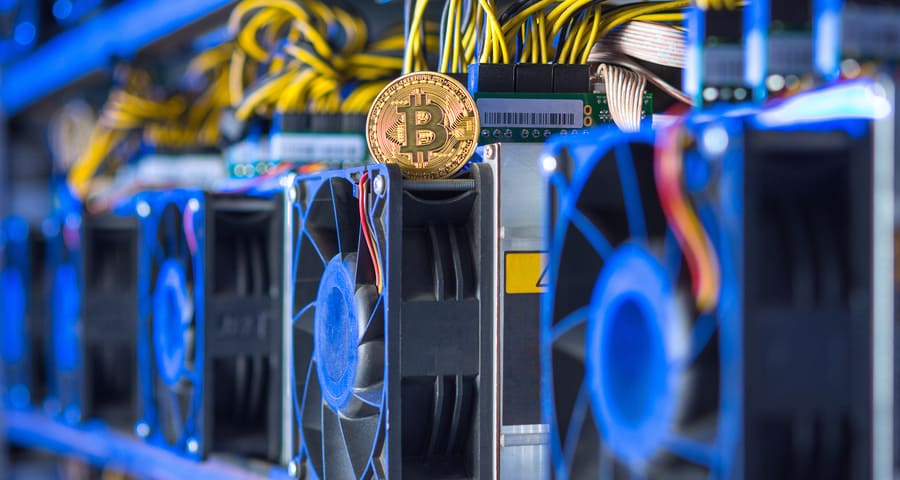You’ve likely already come across this term while reading about cryptocurrencies. I’ll bet that your first reaction was confusion: after all, cryptocurrencies are virtual, and a mine reminds us of a place that is all too real, where the thud of pickaxes is mixed with sarcastic curses. What is cryptocurrency mining, where does the term come from and what is the role of mines in the functioning of alternative payment systems such as Bitcoin or Ethereum? We explain below.
Cryptocurrency mining requires good hardware
To start off with, it would be appropriate to say that cryptocurrency mining obviously does not require physical strength. Moreover, it also does not involve the brain, as it is not a human activity. The role of “miners” (people engaged in currency mining) consists only of providing their computer equipment to a given network. All the work is done by the computer.
However, this consumes huge resources of computing power, so a home PC, although theoretically can be used for this purpose, does not actually produce measurable results. Mining cryptocurrencies requires specialized equipment, the so-called excavators, which process data very quickly. A cryptocurrency excavator is a device designed solely to extract more “coins” from the resources of the system (i.e. to mine). Sounds mysterious? Well, what is mining? What do excavators do? What is the difference between a cryptocurrency mine and an excavator?
The blockchain technology: key information
Although cryptocurrencies resemble traditional money in many ways, they are fundamentally different – not only in the fact that they are virtual and cannot be withdrawn from an ATM. The circulation of virtual assets itself is characterized by different dynamics. While within the traditional financial system banks and government institutions are the issuers of means of payment, in systems such as Bitcoin, digital “coins” are created as a result of complex mathematical operations performed by cryptocurrency excavators. No one supervises the network, but everyone has access to a record of all transactions made using the cryptocurrency. Each successive transaction is recorded in the register and is non-erasable.
Together with other transactions, it produces so-called blocks – separate higher-level wholes, once and for all defined and deposited in virtual memory. This is what blockchain technology, on which every cryptocurrency system is based, is all about. It allows you to easily determine what amount each individual should hold in their wallet. No one will touch your funds or hack your personal information.
Although cryptocurrencies are characterized by self-regulation and do not need oversight from any institutions, someone needs to watch over the proper functioning of the network for it to function. This task falls to the “miners”, i.e. the owners of the previously mentioned excavators, which someone sets in motion and controls. A larger number of Synchronized excavators is called a cryptocurrency mine (or, more colloquially, a machine park). They connect to each other through a common protocol that allows them to process large amounts of data together. By working on a single machine, it would be impossible to achieve optimal results.
That’s all regarding blockchain technology. Detailed aspects related to its functioning have already been discussed in our other articles – we encourage you to browse our website. Now it is time to look at the mysterious process of mining a currency.
Mining – what is this all about?
Mining cryptocurrencies comes down to processing a large amounts of data, validating new blocks, and then attaching them to an existing chain (blockchain). The block represents, so to speak, the space for issuing new “coins”. Mining is most often based on the Proof-of-Work (PoW) algorithm, which provides the network with the ability to reward “miners” according to the results of their work. To initiate a new block, a specific cryptographic problem must be solved. For example, in the Bitcoin system, the goal is to find A string (hash) that solves the corresponding equation.
Miners must generate an output value consisting of hashed transactions, the hash of the previous block, and a random number. The output value should be less than the target value set by the protocol. The miner that succeeds announces its result to the network. Next, the other miners verify the validity of the hash found – if it turns out to be correct, the block is considered mined, and the miner who solved the task gains a strictly defined number of so-called coins. Of course, the miner must work all the time and have uninterrupted Internet access. In order for a miner to earn something, nowadays an excavator has to operate for nearly six months – so it is rather not worthwhile to mine on a single device. If you have the opportunity, set up a mine and see if it works – if multiple computers are working simultaneously, the results are much better.
The work of miners is essential for the Cryptocurrency network to function. Thanks to their work, the tens of thousands of people who use Bitcoin can be sure that transactions are going well, and that the entire system is running smoothly, powered by the computing power of specialized devices of various types.
Cryptocurrency mines: what is required to become a miner?
In addition to advanced technology devices with high computing power, you will also need the right software. Most often it serves not only as a platform for mining cryptocurrency, but also as an Electronic wallet where you can store bitcoins. This type of software is released into circulation by the creators of the cryptocurrency in question. All you have to do is provide your email address to use it – no one will request your personal information.
Cryptocurrency networks based on blockchain technology are designed to Reward regular miners as much as possible for their work and the power they make available. Therefore, the longer a cryptocurrency mine operates, the more power it uses to maintain the system, the more generously it is rewarded. This is the case, for example, in the Dash system, where mining time is a significant factor in the number of coins obtained.
So far, the rate of return on “mining” could be up to several thousand percent per year. However, the current economic and financial conditions are not conducive to achieving such large profits (although there is no denying that mining is still profitable).

Rate of return on bitcoin mining
Anyone who is seriously considering mining, asks themselves how high the rate of return on this investment can be. You can use Special calculators available online to calculate the rate of return. The problem is that according to one expert, Dr. Hans-Peter Deutsch, these calculators are misleading and the profits from bitcoin mining gradually decrease. Deutsch devoted an interesting article to this issue entitled “Bitcoin Mining Profitability – The Good, The Bad and The Ugly”.
After all, the fact remains that the “deeper” someone mines, the degree of difficulty increases. These calculators are based on the assumption that the profitability of mining remains the same. As the article mentioned above reveals, this is not true: the conditions for mining BTC are constantly changing. The core of the system is equipped with two mechanisms: one with strict regularity increases the difficulty of cryptography (exactly every 2016 blocks, i.e. approximately every 2 weeks); the other makes the number of BTC obtained as a reward for mining decrease by half every 210,000 blocks (every 4 years). As a result of these mechanisms, the rate of return from mining constantly fluctuates and decreases over time. Therefore, the later someone starts mining, the less profit they will gain. Every cryptocurrency mine must face this difficulty – regardless of the equipment used.
What makes BTC mining profitable?
A cryptocurrency mine involves a lot of costs. Investors ask themselves whether the frozen money will pay off and how high the profit will be. The profitability of bitcoin mining depends on the following factors:
- BTC rate,
- the costs of mining (resulting from a contract with an external service provider or from the creation of an in-house mine),
- the degree of difficulty of mining (which, as we have already mentioned, is gradually increasing),
- the number of days remaining until the expiration date after which the mining reward will be halved.
Deutsch emphasizes that when calculating the profitability of mining BTC, it is necessary to firstly take into account the cost of daily “mining”, and not the price of the cryptocurrency. According to the expert, the increase in the price of BTC does not compensate for the decrease in the profitability of mining. The increase in the price of BTC expressed in FIAT currency does not yet make mining profitable. When the exchange rate increases, you can buy the cryptocurrency if you want to make a profit – you do not need to mine it. As Deutsch’s calculations show, if the break-even point is not reached in less than a year, it will become increasingly difficult to reach it later. This is supported by real statistics. A cryptocurrency mine can therefore turn out to be a misguided investment.
What exactly is a cryptocurrency mine?
A cryptocurrency mine is a network of specialized devices that use their computing power to validate subsequent transactions in a database. It can also be defined more precisely: as a protocol that allows many different miners to “join forces” and thus increase the frequency and Predictability of earnings they receive for their work. In each mine, the central role is played by a master server that assigns tasks to miners. Once the miners have completed their tasks, they send the result back to the server for validation and to generate a new block.
As soon as a new block is generated, the server rewards miners who have solved the assigned tasks with coins. This is what every cryptocurrency mine earns. The amount of the reward depends – as we have already mentioned – on the number of solved tasks, meaning the computing power made available to solve them. For example, if a miner has 1% of the shares, he or she will receive 1% of the reward. This way everyone is Rewarded fairly. You do not have to worry about someone else benefiting from your results. Many different ways of converting the shares have been developed so far, but this is a topic that requires a separate article. You can easily find more detailed information online.
SUMMARY
A cryptocurrency mine consumes a lot of electricity – some miners have 10 graphics cards each, or more. Setting up a mining platform is therefore very expensive. These devices analyse huge amounts of data, and they need special software to process the information, with the help of which they solve complex cryptographic tasks. According to surveys, mines are created primarily on the initiative of companies. However, private individuals are also opting for mining more broadly. Thanks to this, systems such as Bitcoin or Stellar can still function without the help of external institutions. Or perhaps you too, would like to start a cryptocurrency mine? First, take a look at what a cryptocurrency mine looks like, find out what costs it involves and whether you will be able to afford it. Remember that bitcoin mining is not the only way to make money from cryptocurrencies – you have other options as well. Small investments on the stock exchange are far less risky, for example. Useful information about investing can be found online – as well as on our website (simply check out the table of contents).

